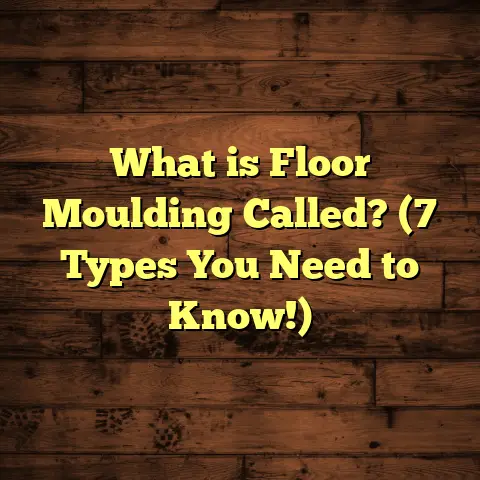What is Radiant Heat Laminate Flooring? (5 Benefits You Must Know)
Have you ever walked across your floor in the middle of winter and instantly regretted not putting on slippers first? I know I have. That cold, biting sensation underfoot can make even the coziest room feel uninviting. I once helped a family who kept their thermostat high just to combat cold floors—and their energy bills were through the roof. They didn’t realize how much comfort they were missing until we installed radiant heat laminate flooring. It changed everything for them. And it could do the same for you.
What is Radiant Heat Laminate Flooring?
Radiant heat laminate flooring combines two things: radiant heating systems installed beneath the floor and laminate flooring laid on top. Radiant heat systems work by distributing warmth evenly from the floor surface up into the room, rather than blowing hot air around like traditional forced-air heating. This means the heat rises gently and consistently, warming your entire space in a way that feels natural and comfortable.
Laminate flooring is a type of synthetic flooring that looks like wood, stone, or other materials but is made from layers of fiberboard topped with a photographic image and protective coating. It’s popular because it’s affordable, durable, and comes in a wide range of styles.
When you combine radiant heat with laminate flooring, you get a warm, stylish, and efficient floor that makes your home feel cozy while saving energy.
How Does Radiant Heat Work?
Radiant heating systems usually come in two forms:
- Electric radiant heat mats: Thin cables woven into mats are rolled out under the floor covering.
- Hydronic radiant systems: Tubing embedded in the floor circulates hot water heated by a boiler or water heater.
Both systems warm the floor surface directly. Because heat naturally rises, it creates an even temperature gradient from floor to ceiling.
This form of heating is more efficient because it warms objects and people directly, rather than just heating air that can easily escape or be cooled by drafts.
Why Laminate Flooring?
You might ask why laminate is a good match for radiant heat. Well, laminate flooring has several advantages over other materials when used with radiant systems:
- It has moderate thermal conductivity, which means it transfers heat well without overheating.
- It’s thinner and easier to install over radiant mats compared to tile or stone.
- It’s durable enough to handle temperature changes without warping.
- It offers a wide variety of looks at a fraction of hardwood or stone costs.
But not all laminates are created equal—some aren’t made for use with radiant heat because they can warp or delaminate when exposed to consistent warmth. Always look for laminate flooring specifically rated for radiant heat installation.
1. Cozy Warmth Underfoot — A Comfort You’ll Notice Instantly
One of the biggest reasons I recommend radiant heat laminate flooring is the incredible comfort it delivers. Have you ever stepped out of bed or off a cold bathroom tile floor and felt that shock of cold? With radiant heat under laminate flooring, that’s something you can say goodbye to.
I remember a client who was skeptical about this—she thought it sounded like a gimmick. After installation, she told me she finally enjoyed sitting on her living room floor playing with her kids without reaching for socks or slippers first. That warmth is subtle but constant; it’s like your entire room embraces you gently.
According to research by the U.S. Department of Energy, radiant heating warms people and objects directly rather than just air. This results in a more pleasant feeling at lower thermostat settings, so you stay comfortable without cranking up energy use.
And it’s not just about feeling warm; it’s about how that warmth spreads evenly. With forced-air heating, vents can create hot spots near them and cold spots far away. Radiant heat eliminates this unevenness because it’s distributed uniformly beneath your feet.
2. Energy Savings That Add Up Over Time
Comfort is great, but what about cost? I’ve heard from many homeowners who worry that radiant heat might spike their electric bills or heating costs. In reality, it often leads to savings.
Why? Because radiant heat warms objects and people directly, it requires less overall energy to maintain comfort. You don’t have to crank up your thermostat as high because the floor itself radiates warmth.
A study by Oak Ridge National Laboratory found that homes with radiant floor heating could lower their thermostat settings by 7 to 10 degrees Fahrenheit without sacrificing comfort. This can reduce energy consumption by an average of 20%.
In my experience working with clients in colder climates like Minnesota and Wisconsin, those who switched to radiant heat laminate floors reported noticeably lower heating bills after installation—sometimes up to 15-25% savings annually.
There’s also another factor: radiant floors retain heat well. Even after the system turns off, the floors stay warm longer than forced-air systems where heated air quickly escapes through windows or doors. This means you get more bang for your buck when heating your home.
3. Style and Practicality Rolled Into One
Laminate flooring has come a long way since its early days of cheap-looking patterns and plastic finishes. Modern laminate offers realistic wood grains, stone textures, and even tile looks that rival natural materials at a fraction of the cost.
One thing I love when working with clients is helping them choose laminate styles that match their home’s character without sacrificing warmth or durability.
Pairing this with radiant heat means you don’t have to pick between style and comfort—you get both.
Laminate floors are also easier to maintain than hardwood or stone. They resist stains, scratches, and moisture better (especially if you choose waterproof varieties), making them perfect for busy families or pet owners.
On top of that, laminate flooring is usually thinner than hardwood or tile, making it compatible with electric radiant mats without raising floor height too much or requiring extensive adjustments to doors and baseboards.
4. Installation That Won’t Break Your Back
Radiant heat systems can sound intimidating to install, especially hydronic ones that require plumbing work and concrete pours. But electric radiant mats paired with laminate flooring simplify this significantly.
I’ve installed electric radiant heat mats under laminate planks in kitchens and bathrooms in just a couple of days. The mats are thin—only a few millimeters thick—and flexible enough to roll out easily on existing subfloors.
Once the mats are connected electrically and tested, you simply lay down your laminate flooring on top using floating floor techniques (no glue or nails needed). This makes installation faster and less messy than pouring heated concrete slabs or doing tile work.
Because laminate flooring expands and contracts slightly with temperature changes, you also don’t need to worry about cracking grout lines or tiles separating as sometimes happens with heated stone floors.
For homeowners looking to do some DIY work combined with professional electrician help, this system is manageable and cost-effective.
5. Low Maintenance That Keeps Giving
One of the best parts about radiant heat laminate floors is how easy they are to maintain once installed. Unlike forced-air systems that require regular duct cleaning or furnace servicing, your heating cables or tubes are safely tucked beneath the floor surface where they’re protected from damage.
Laminate floors themselves are simple:
- Sweep or vacuum regularly to remove dirt and grit.
- Use a damp mop with laminate-friendly cleaner—avoid soaking floors.
- Wipe spills quickly to avoid staining.
- Avoid abrasive cleaners or steam mops that can damage the protective layer.
- Keep furniture pads under legs to prevent scratches.
Since the heating system doesn’t have moving parts exposed to dust or wear (like fans or filters), it typically lasts for decades with minimal service—especially electric mats which have no water lines that could leak or corrode.
What I’ve Learned from Real Projects: Case Studies & Stories
Over the years, I’ve worked on dozens of projects involving radiant heat laminate flooring—each one teaching me something new.
Case Study #1: Small Bathroom Renovation
A client called me frustrated with her cold bathroom tiles in January. She wanted warmth but didn’t want expensive tile replacement or complicated plumbing.
We installed electric radiant mats beneath new waterproof laminate planks designed for wet areas. The project took two days from start to finish.
Result? She now enjoys stepping out of the shower onto warm floors every morning and said her utility bills actually decreased slightly because she lowered her thermostat at night.
Case Study #2: Large Living Room Remodel
Another homeowner wanted cozy living room floors but had an old subfloor not suited for heavy tile installation.
We laid hydronic tubing beneath plywood subflooring topped with engineered underlayment and installed oak-look laminate planks rated for radiant heat.
The system integrated well with their existing boiler. Their house felt warmer overall with more even temperatures throughout the winter months.
Personal Story: My Own Kitchen Upgrade
I installed electric radiant heat under my kitchen laminate floors three years ago. I wanted comfort during long cooking sessions on cold mornings.
What amazed me was how fast the system heated up—less than 15 minutes after turning on—and how even the warmth felt underfoot compared to my old forced-air heaters.
The energy savings were noticeable too; my winter heating bills dropped by about 12% compared to previous years despite keeping the house just as warm.
Detailed Tips for Installation Success
If you decide to install radiant heat laminate flooring yourself or hire pros, these tips can help avoid common problems:
- Select Proper Laminate: Always buy laminate flooring rated for use with radiant heating. Check manufacturer specs on maximum surface temperature tolerance (usually around 85°F).
- Prepare Subfloor: Clean, level, and dry subflooring before laying mats or tubing. Uneven surfaces can cause damage or uneven heating.
- Choose Suitable Underlayment: Use underlayments designed for radiant heat systems; they optimize heat transfer while protecting cables/tubes.
- Hire Licensed Electricians: For electric systems, professional wiring is essential for safety and code compliance.
- Test Heating System Before Flooring: Turn on mats/tubes and measure temperatures before installing laminate planks to spot faults early.
- Leave Expansion Gaps: Laminate expands/contracts slightly; follow manufacturer guidelines on gap size around edges to prevent buckling.
- Control Humidity: Radiant floors work best in stable humidity environments (35%-65%). Use humidifiers/dehumidifiers if needed.
Understanding Costs — What You Can Expect
Cost is always a factor when considering new flooring options with heating systems.
Here’s a rough breakdown based on my experience:
| Component | Cost Estimate (per sq ft) |
|---|---|
| Electric Radiant Heat Mats | $8 – $12 |
| Hydronic Radiant Tubing | $6 – $10 (excluding boiler/plumbing) |
| Laminate Flooring | $2 – $6 (varies by quality/style) |
| Underlayment | $0.50 – $1 |
| Installation Labor | $3 – $7 |
So for an average 200 sq ft room using electric mats plus mid-range laminate, you might expect total costs between $2,600 – $5,000 including materials and labor.
To manage these numbers effectively during budgeting, I rely on tools like FloorTally that let me input exact room dimensions, select specific products in my area, and see detailed cost estimates all in one place. This prevents surprises by factoring in waste percentages and local labor rates automatically.
It also helps me compare different scenarios quickly—for example, electric versus hydronic systems or various laminate grades—so clients can make informed choices based on their budgets without guesswork.
Maintenance Insights: Keeping Your Floors Healthy
Radiant heat laminate floors don’t demand special maintenance routines beyond what you’d do for normal laminate floors—but here are some pointers based on what I’ve seen:
- Avoid Excess Water: Always mop damp rather than wet; standing water can seep into seams.
- Use Soft Cleaning Tools: Microfiber mops are gentle yet effective.
- Prevent Scratches: Furniture pads and rugs in high traffic areas help preserve finish.
- Monitor Heating System: Schedule occasional checks (every few years) especially for hydronic systems.
- Watch for Signs: If you notice uneven warmth or cold spots, have a pro inspect wiring or tubing early before bigger repairs are needed.
Frequently Asked Questions About Radiant Heat Laminate Flooring
Can I install radiant heat under any type of laminate?
Nope! Only laminates rated for radiant heat use should be installed over these systems as others may warp or delaminate due to heat exposure.
Is electric or hydronic better?
Electric mats are easier and cheaper to install—great for small rooms or retrofits. Hydronic systems are more cost-effective long-term for large areas but require plumbing adjustments upfront.
Will radiant heat damage my laminate?
If installed correctly using compatible materials and within temperature limits (usually max 85°F), no damage should occur.
How long does installation take?
Electric mat installations under laminate typically take 1-3 days depending on room size; hydronic setups take longer due to plumbing work.
Does this system add height to my floors?
Electric mats are very thin (~3mm), so minimal height increase occurs—often manageable without adjusting doors/baseboards much.
Wrapping Up My Thoughts
Radiant heat laminate flooring has been a favorite solution in my projects because it solves cold-floor problems elegantly while offering style flexibility and energy savings. It’s a combination that delivers real comfort—not just hype—making homes more livable during chilly seasons without breaking the bank.
If you’re tired of freezing toes indoors or want a practical way to cut heating costs while upgrading your floors aesthetically, this option deserves serious attention.
Feel free to reach out anytime if you want advice tailored to your home setup—I’m happy to share what I’ve learned firsthand from years of installing these systems!
That’s all from me on radiant heat laminate flooring! If you’ve got questions or want tips on picking products or installers near you, just ask—I’m here to help make your floors warm and welcoming wherever you live.





